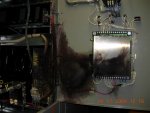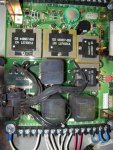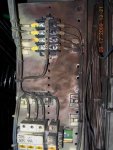dontheo
Member
- Location
- The Great State of Texas
First, a big thank you to everyone that helpe me through my 3 phase pump problem. I made the installer do his job as he should have and we are in specification .
.
So now this. The plant service tch called and said the generator was running. No faults on any of the wiring, and everything looked good.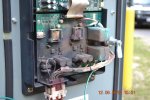
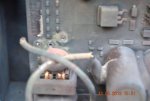 e
e
This pictre is from the front cover of transfer switch for a 125KW Kohler Generator and is the logic board. It actually is on the door itself. It is covered by a black plastic cover I removed to take these pictures. The bottom right of the board shows the two wires completely burned off and the flash and charring moving from the bottom left to the top right. The reason I mention this is two companies decribed this to me before I told them what it looked like. With no problems in the past, a stringent maintenance program I maintain that irritates the hell out of everyone, I am at a loss for the reason why. It looks like something shorted to ground. This is Texas, and even in an outdoor enclosure there were wasps inside the cabinet. Or as we call them, Warsps. Not sure if they had anything to do with it or not. I could not find any fired or parts of one like it had taken on a claynore. Just thought I would post this.
The Don
So now this. The plant service tch called and said the generator was running. No faults on any of the wiring, and everything looked good.

 e
eThis pictre is from the front cover of transfer switch for a 125KW Kohler Generator and is the logic board. It actually is on the door itself. It is covered by a black plastic cover I removed to take these pictures. The bottom right of the board shows the two wires completely burned off and the flash and charring moving from the bottom left to the top right. The reason I mention this is two companies decribed this to me before I told them what it looked like. With no problems in the past, a stringent maintenance program I maintain that irritates the hell out of everyone, I am at a loss for the reason why. It looks like something shorted to ground. This is Texas, and even in an outdoor enclosure there were wasps inside the cabinet. Or as we call them, Warsps. Not sure if they had anything to do with it or not. I could not find any fired or parts of one like it had taken on a claynore. Just thought I would post this.
The Don


